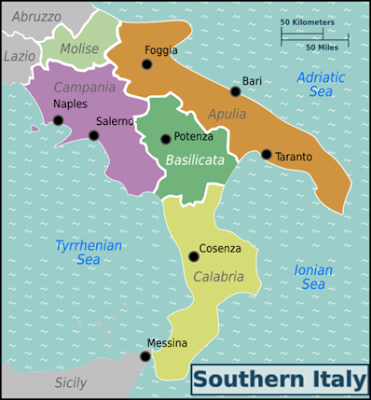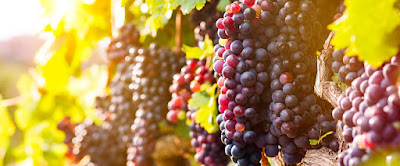I wrap up this month’s feature on the regions of Molise, Campania and the Basilicata with a look into the Basilicata wine region. This region is one of the smallest regions in Italy with acres to vines. It is located in southern Italy situated between the regions of Campania, Puglia and Calabria. A small amount of the Basilicata lines the coast with the Tyrrhenian Sea to the southwest and the Ionian Seas on the southeast.
 |
| Copyright of Wikivoyage |
The Basilicata is a rugged terrain from the Apennines Mountains and hills that occupy about 90% of the territory. There is a small amount of plains that are located closer to the sea. The non-active volcano, Monte Vulture, is located in the northwest corner with altitudes about 4,300 feet where many of the Basilicata’s vineyards are located. With such a mix of geography, the climate is continental with a higher amount of precipitation around the mountains and a mediterranean climate near the sea.
 |
| Monte Vulture - Copyright of Michael Nielsen |
With the varied geography also comes a variety of
soils. Surrounding Monte Vulture the
soils are rich volcanic soils as one would imagine. The hills are full of clay and closer to the
sea the soils are sandy with marine sediments.
The Basilicata is dominated by red wines with about
70-80% of the overall production. The Aglianico grape is the primary red
grape representing more than half of the wines. The only DOCG in the Basilicata
is Aglianico del Vulturno Superiore DOCG that was promoted to this level in
2010 from the DOC originally established in 1971. This is one of the respected wines of Italy and shares similarities with neighboring Campania's Taurasi and Aglianico del Taburno.
You will find Aglianico produced under both the DOC and DOCG designations with varying regulations. Those of the Aglianico DOC can be released a year after harvest, but from the Aglianico del Vulture Superiore DOCG the yields are stricter, higher alcohol levels are required and aging must be a minimum of 3 years with at least 1 year in wood and 1 in the bottle.
 |
| Sourced from Consorzio di Tutela Aglianico del Vulture |
No comments:
Post a Comment